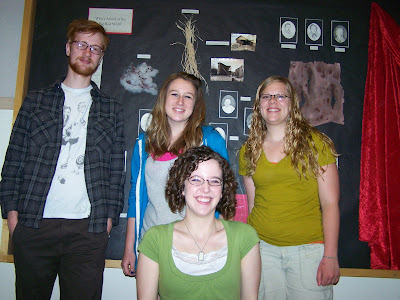Rough Sketches
The findings, musings, and workings of a beginning art student.
Wednesday, May 11, 2011
Museum Project
So since I'm kind of ashamed over my last couple artist posts, I'll end with something I'm not ashamed of: our last big project!
Assigned to create a museum exhibit, my group decided to create an exhibit on the court case for the Big Bad Wolf. Though we originally were going to set the case in "fairy tale land," eventually we decided to concoct a story about a real-life serial killer who inspired the three fairy tales.
Here's our project proposal:
My group was awesome. Jordan gathered physical evidence and destroyed grandma's nightgown. Ammie altered photos and designed/printed/transfered the newspaper template. Cory drew portraits and court drawings, and I composed newspaper articles, our introduction, and our concluding statements as well as printed and cut out all the tags for the exhibit. I think things came together pretty nicely!
Assigned to create a museum exhibit, my group decided to create an exhibit on the court case for the Big Bad Wolf. Though we originally were going to set the case in "fairy tale land," eventually we decided to concoct a story about a real-life serial killer who inspired the three fairy tales.
Here's our project proposal:
Installation Proposal for Anne-Marie Kottenstette, Jordan Munroe, Cory McCormick, and Kate Huebschmann
Concept
In our culture, the Big Bad Wolf is instantly recognized as an embodiment of evil, but that recognition indicates more about us than we would originally think about. This piece will depict the way in which a sense of law and justice is instilled in us from an early age. Fairy tales act as ways of providing a moral foundation for society by shaping children’s ideas of what is right and what is wrong. By taking what originally belongs in the realm of childhood and transferring it into a setting that is generally associated with adults, the piece provides a visual link between our upbringings and our cultural morality.
Elements to Include
This piece will depict a historical record of the trial of the Big Bad Wolf. Group members will create evidence or historical documentation such as crime scene photos, physical evidence (remnants of Grandma’s nightgown, debris from the Three Little Pigs’ homes, etc.), court drawings, testimonies and portraits of victims or witnesses, headlines from newspapers, or anything else we decide to include.
The piece will reference the following fairy tales:
· Red Riding Hood
· Three Little Pigs
· Peter and the Wolf
· Boy Who Cried Wolf
Installation
All evidence, court drawings, and documentation will be located in one vitrine. Our artists’ statement will appear as the court case’s opening statement on the vitrine’s left side. The court case will be presented left to right with the final verdict appearing at the far right. Evidence from each fairy tale will be presented in order of “occurrence” with all physical evidence being displayed at the front of the case and all drawings and photographs mounted along the back of the case.
Possible Items Needed
· Paper
· Camera
· Tags
· Dirt
· Basket w/flowers
· Red fabric/cape
· Hay/sticks/bricks
· Cloth/clothing
· Wallpaper with red paint
· Feathers
· Wool
My group was awesome. Jordan gathered physical evidence and destroyed grandma's nightgown. Ammie altered photos and designed/printed/transfered the newspaper template. Cory drew portraits and court drawings, and I composed newspaper articles, our introduction, and our concluding statements as well as printed and cut out all the tags for the exhibit. I think things came together pretty nicely!
Featured Artist: Florian Maier-Aichen
Again, I'm sorry it's so short.
Florian Maier-Aichen’s images offer reinterpretations of traditional landscape photography. Often shot at obscure angles or from aerial views, he represents sites in a way that makes the viewer feel slightly dislocated, addressing ideas of globalization and virtual perception. This dislocation is multiplied by the computer enhancement he performs on the photos, heightening the images’ tension. Replacing classical landscapes with futuristic scenes, Maier-Aichen takes the romantic idea of the sublime and places it within the context of modern day life and experience.
Though photography is inherently considered a “documentary” art form, Maier-Aichen approaches it as a way of creating illusion. Fact and fiction are indistinguishable in his pictures, creating an impression of constant change.

Untitled, Print, 2005

Untitled, Print, 2005

Untitled (Freeway Crash), Print, 2002

Untitled, Print, 2005
Florian Maier-Aichen’s images offer reinterpretations of traditional landscape photography. Often shot at obscure angles or from aerial views, he represents sites in a way that makes the viewer feel slightly dislocated, addressing ideas of globalization and virtual perception. This dislocation is multiplied by the computer enhancement he performs on the photos, heightening the images’ tension. Replacing classical landscapes with futuristic scenes, Maier-Aichen takes the romantic idea of the sublime and places it within the context of modern day life and experience.
Though photography is inherently considered a “documentary” art form, Maier-Aichen approaches it as a way of creating illusion. Fact and fiction are indistinguishable in his pictures, creating an impression of constant change.

Untitled, Print, 2005

Untitled, Print, 2005

Untitled (Freeway Crash), Print, 2002

Untitled, Print, 2005
Featured Artist: Philip Guston
So I was celebrating that I had the official 8 artists in when I realized I never put in the missing two from last time. I'm utterly and completely out of descriptive creativity, thus these won't be nearly as detailed as my other entries. Will be "borrowing" a lot of info too. I'm sorry! :(
Philip Guston began his career painting scenes of social issues before becoming well known for his work in Abstract Expressionism, which often depicted blocks, masses of gestural strokes, and marks of color. During the 1960-70s, Guston returned to representational painting, though this time his characters were stylized, abstracted, cartoonish.

To BWT, Oil on canvas, 1952
“The upheavals of 1960s made Guston increasingly uncomfortable with abstract painting, and his work eventually developed into the highly original cartoon-styled realism for which he is now best known. This took him back to his early years - to the style of the comics he loved as a boy, and to the imagery of Klansmen that he first explored in the 1930s.”

Bad Habits, Oil on canvas, 1970
“These images are [often] populated by enigmatic hooded figures, reminiscent of members of the Klu Klux Klan; they are not meant to directly reference racism but rather to take a stand against war, injustice, and the hypocrisy Guston witnessed in American politics. During the years before his death in 1980, Guston continued to hone this imagery, creating increasingly enigmatic compositions reminiscent of still lives or spare landscapes, with clusters of figures, heavy boots and tools, and cycloptic heads” (http://www.theartstory.org/artist-guston-philip.htm)

Edge of Town, Oil on canvas, 1969

Head and Bottle, 1975
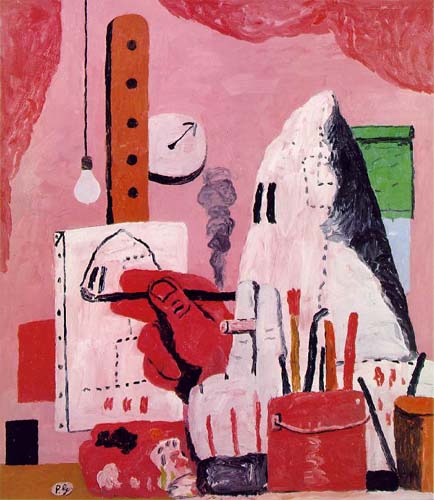
The Studio, Oil on canvas, 1969
Philip Guston began his career painting scenes of social issues before becoming well known for his work in Abstract Expressionism, which often depicted blocks, masses of gestural strokes, and marks of color. During the 1960-70s, Guston returned to representational painting, though this time his characters were stylized, abstracted, cartoonish.

To BWT, Oil on canvas, 1952
“The upheavals of 1960s made Guston increasingly uncomfortable with abstract painting, and his work eventually developed into the highly original cartoon-styled realism for which he is now best known. This took him back to his early years - to the style of the comics he loved as a boy, and to the imagery of Klansmen that he first explored in the 1930s.”

Bad Habits, Oil on canvas, 1970
“These images are [often] populated by enigmatic hooded figures, reminiscent of members of the Klu Klux Klan; they are not meant to directly reference racism but rather to take a stand against war, injustice, and the hypocrisy Guston witnessed in American politics. During the years before his death in 1980, Guston continued to hone this imagery, creating increasingly enigmatic compositions reminiscent of still lives or spare landscapes, with clusters of figures, heavy boots and tools, and cycloptic heads” (http://www.theartstory.org/artist-guston-philip.htm)

Edge of Town, Oil on canvas, 1969

Head and Bottle, 1975

The Studio, Oil on canvas, 1969
Tuesday, May 10, 2011
Featured Artist: Shigeo Fukuda
And now for something completely different...
Japanese graphic artist and designer, Shigeo Fukuda, enjoyed using visual contradictions, illusions, and abnormal combinations of objects in his works of art, which ranged from posters to complex sculptures.
Fukuda's sense of moral responsibility is shown through his posters, addressing social causes such as pacifism and environmentalism. His most famous poster, Victory 1945, depicts a cannon barrel with its shell pointing downward, back towards the barrel, sealing it forever. The simple design offers a biting criticism of the pointlessness of war.

Victory 1945, offset process, 1975
Though his posters are beautiful, I find Fukuda’s illusionistic art to be more fascinating. His work spans both two-dimensional and three-dimensional mediums including impossible objects, ambiguous sculptures, distorted projections, and anamorphic art.
He once described his philosophy this way: "I believe that in design, 30% dignity, 20% beauty and 50% absurdity are necessary. Rather than catering to the design sensitivity of the general public, there is advancement in design if people are left to feel satisfied with their own superiority, by entrapping them with visual illusion."

Constructed out of 848 forks, knives, and spoons, Lunch with Helmet On appears to be a formless object until a light is shone behind it from a certain angle. Suddenly the impossible shadow of a motorcycle appears out of the chaos.

Lunch with Helmet On, Knives, forks, and spoons, 1987
Similarly, his Duet was a structure which looked like a pianist from one angle and a violinist from another.

Duet
Fukuda also created structures based on M. C. Escher’s lithograph prints, which distorted space and perspective to create “impossible objects” which could not exist in three dimensions. An example of this was his Disappearing Column a three-dimensional rendering of the famous impossible trident.

Disappearing Column, Sculpture in wood, 1985
Taking advantage of an Ames Projection, Fukuda has constructed a bizarre piano so that the lines of it still coincide with the lines of sight of a real piano. Seen from one special angle, the reflection of the physical model looks perfectly normal.
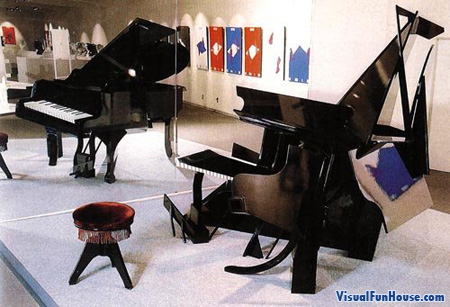
Japanese graphic artist and designer, Shigeo Fukuda, enjoyed using visual contradictions, illusions, and abnormal combinations of objects in his works of art, which ranged from posters to complex sculptures.
Fukuda's sense of moral responsibility is shown through his posters, addressing social causes such as pacifism and environmentalism. His most famous poster, Victory 1945, depicts a cannon barrel with its shell pointing downward, back towards the barrel, sealing it forever. The simple design offers a biting criticism of the pointlessness of war.

Victory 1945, offset process, 1975
Though his posters are beautiful, I find Fukuda’s illusionistic art to be more fascinating. His work spans both two-dimensional and three-dimensional mediums including impossible objects, ambiguous sculptures, distorted projections, and anamorphic art.
He once described his philosophy this way: "I believe that in design, 30% dignity, 20% beauty and 50% absurdity are necessary. Rather than catering to the design sensitivity of the general public, there is advancement in design if people are left to feel satisfied with their own superiority, by entrapping them with visual illusion."

Constructed out of 848 forks, knives, and spoons, Lunch with Helmet On appears to be a formless object until a light is shone behind it from a certain angle. Suddenly the impossible shadow of a motorcycle appears out of the chaos.

Lunch with Helmet On, Knives, forks, and spoons, 1987
Similarly, his Duet was a structure which looked like a pianist from one angle and a violinist from another.

Duet
Fukuda also created structures based on M. C. Escher’s lithograph prints, which distorted space and perspective to create “impossible objects” which could not exist in three dimensions. An example of this was his Disappearing Column a three-dimensional rendering of the famous impossible trident.

Disappearing Column, Sculpture in wood, 1985
Taking advantage of an Ames Projection, Fukuda has constructed a bizarre piano so that the lines of it still coincide with the lines of sight of a real piano. Seen from one special angle, the reflection of the physical model looks perfectly normal.

Featured Artist: ROA
ROA is street artist renowned for his fascinatingly detailed spray paint art featuring black and white animals that can be found inhabiting cities all over the world, all in varying stages of decay. To some, using public spaces as canvases is vandalism, simple defacement of property. Others see ROA’s work as refreshing, unrestrained by financial gain or institutional demands.

He seems to find inspiration in adversity, choosing to depict animals that get overlooked, yet persevere despite man’s determination to destroy. Giant black and white ant eaters, enormous rats, decaying rabbits, skunks, ferrets, sloths, raccoons and birds constitute much of ROA’s repertoire, yet something feels slightly odd about his depictions, something that gives them an edge. “Even when they appear cuddly there is something beneath them that defies the cute tag – if not a danger then something urgent at the periphery of our vision which we can’t quite make out” (http://www.kuriositas.com/2010/11/roa-mysterious-belgian-street-artist.html).

At times, ROA sketches out his images before painting them, but generally, he draws inspiration from images he finds on the web. Sometimes he uses white latex paint to create a canvas for his works, most are created with spray paint alone.

I love how he incorporates setting so much into his work. The animals seem more like an extension of their environment than an intrusion upon it. Even the types of animals he uses reflects the setting in which they are placed. Fish fly from broken toilets, armadillos crawl from abandoned buildings in Mexico, rats and cockroaches crawl from rubble in NYC. I love it!





ROA's work is featured in many cities, including London, Berlin, NYC, and Barcelona as well as his home town of Ghent.

He seems to find inspiration in adversity, choosing to depict animals that get overlooked, yet persevere despite man’s determination to destroy. Giant black and white ant eaters, enormous rats, decaying rabbits, skunks, ferrets, sloths, raccoons and birds constitute much of ROA’s repertoire, yet something feels slightly odd about his depictions, something that gives them an edge. “Even when they appear cuddly there is something beneath them that defies the cute tag – if not a danger then something urgent at the periphery of our vision which we can’t quite make out” (http://www.kuriositas.com/2010/11/roa-mysterious-belgian-street-artist.html).

At times, ROA sketches out his images before painting them, but generally, he draws inspiration from images he finds on the web. Sometimes he uses white latex paint to create a canvas for his works, most are created with spray paint alone.

I love how he incorporates setting so much into his work. The animals seem more like an extension of their environment than an intrusion upon it. Even the types of animals he uses reflects the setting in which they are placed. Fish fly from broken toilets, armadillos crawl from abandoned buildings in Mexico, rats and cockroaches crawl from rubble in NYC. I love it!





ROA's work is featured in many cities, including London, Berlin, NYC, and Barcelona as well as his home town of Ghent.
Featured Artist: Maya Lin
At 21 years old, Maya Lin’s entry won the Vietnam Veterans Memorial’s design contest, launching her into a career as one of the most important current public artists with works ranging from large-scale, site-specific installations, to intimate studio artworks, architectural works, and memorials.
![[peacechapel2.jpg]](https://blogger.googleusercontent.com/img/b/R29vZ2xl/AVvXsEhPc_SBQltk-f3Gy0tXvi1fE_vQZuSHaQQgGzZanuUI0cnnNCQZM4LJXxqQkS_ARfZxplF-7bkAUQP1xABqek92kQHmnH3gFo9cPzgUL5CNsu3urmiLxd65QkpeSIFjp6UfORN5X8t1ON61/s1600/peacechapel2.jpg)
Peace Chapel, Juniata College, 1988-89
Landscape is the focus of much of Lin's art, merging the technological advancement and style of modern day life with ideas of natural beauty. “Her works address how we relate and respond to the environment, and presents new ways of looking at the world around us” (http://www.mayalin.com/). Some of her pieces are partially or fully embedded in the earth, merging completely with the environment, blurring the boundaries between the natural and the synthetic.

Eleven Minute Line, Earth and Grass, 2004
An example of such works is The Wavefield at University of Michigan, which consists of tall, undulating waves made entirely of soil and grass, and the Vietnam Memorial, a V-shaped wall of black stone, sunken into the earth, etched with the names of 58,000 dead soldiers.

Wave Field, Earth and grass, 1995

Vietnam Veterans Memorial, Stone, 1982

Vietnam Veterans Memorial, Stone, 1982

Vietnam Veterans Memorial, Stone, 1982
Her Civil Rights memorial in Montgomery, Alabama displays inscriptions on a disc of black stone beneath a thin layer of moving water. On the disc are names of people who died in the name of civil rights and the dates of important events in civil rights’ history. Lin describes the piece in her book, Boundaries: “In choosing to intertwine events with people's deaths, I was trying to illustrate the cause-and-effect relationship between them. The struggle for civil rights in this country was a people's movement, and a walk around the table reveals how often the act of a single person -- often enough, a single death -- was followed by a new and better law.”
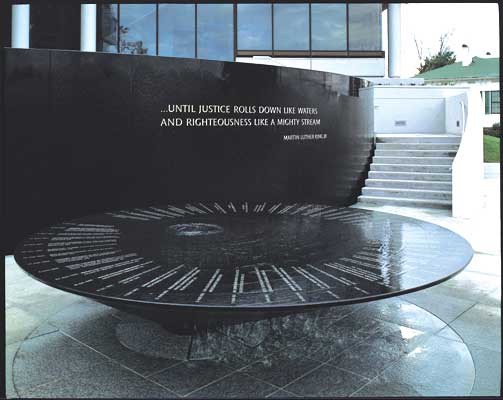
Civil Rights Memorial, Stone and Water, 1989
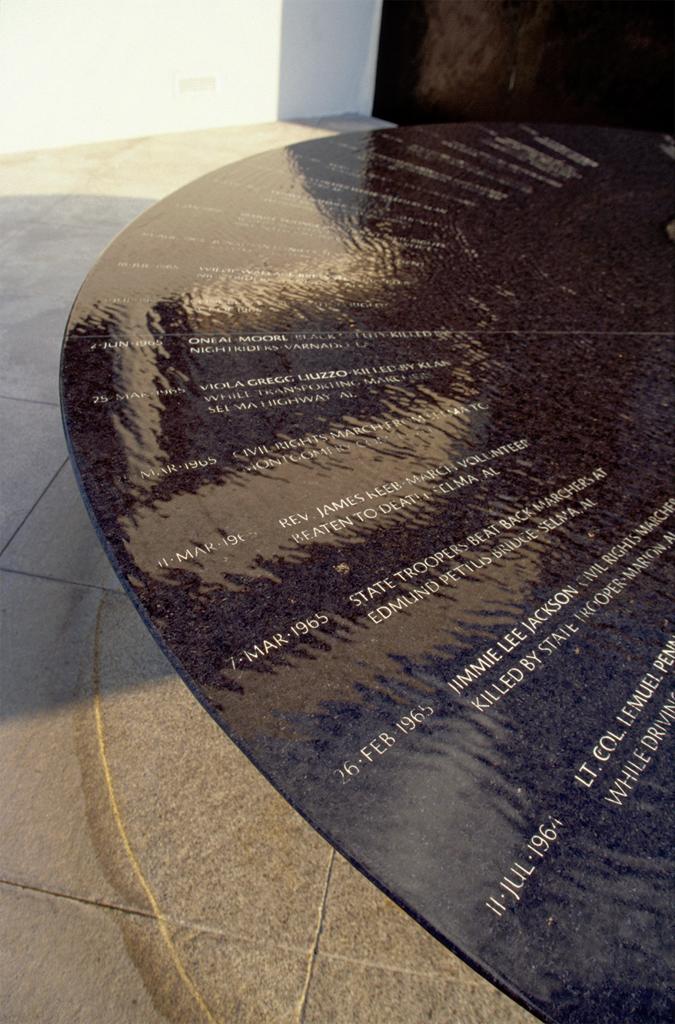
Civil Rights Memorial, Stone and Water, 1989
Not just an environmental artist, Lin’s studio works also reflect her love of landscape.

2 x 4 Landscape, Wood, 2006

Blue Lake Pass, Particleboard, 2006

Water Line, Aluminum Tubing & Paint, 2006
![[peacechapel2.jpg]](https://blogger.googleusercontent.com/img/b/R29vZ2xl/AVvXsEhPc_SBQltk-f3Gy0tXvi1fE_vQZuSHaQQgGzZanuUI0cnnNCQZM4LJXxqQkS_ARfZxplF-7bkAUQP1xABqek92kQHmnH3gFo9cPzgUL5CNsu3urmiLxd65QkpeSIFjp6UfORN5X8t1ON61/s1600/peacechapel2.jpg)
Peace Chapel, Juniata College, 1988-89
Landscape is the focus of much of Lin's art, merging the technological advancement and style of modern day life with ideas of natural beauty. “Her works address how we relate and respond to the environment, and presents new ways of looking at the world around us” (http://www.mayalin.com/). Some of her pieces are partially or fully embedded in the earth, merging completely with the environment, blurring the boundaries between the natural and the synthetic.

Eleven Minute Line, Earth and Grass, 2004
An example of such works is The Wavefield at University of Michigan, which consists of tall, undulating waves made entirely of soil and grass, and the Vietnam Memorial, a V-shaped wall of black stone, sunken into the earth, etched with the names of 58,000 dead soldiers.

Wave Field, Earth and grass, 1995

Vietnam Veterans Memorial, Stone, 1982

Vietnam Veterans Memorial, Stone, 1982

Vietnam Veterans Memorial, Stone, 1982
Her Civil Rights memorial in Montgomery, Alabama displays inscriptions on a disc of black stone beneath a thin layer of moving water. On the disc are names of people who died in the name of civil rights and the dates of important events in civil rights’ history. Lin describes the piece in her book, Boundaries: “In choosing to intertwine events with people's deaths, I was trying to illustrate the cause-and-effect relationship between them. The struggle for civil rights in this country was a people's movement, and a walk around the table reveals how often the act of a single person -- often enough, a single death -- was followed by a new and better law.”

Civil Rights Memorial, Stone and Water, 1989

Civil Rights Memorial, Stone and Water, 1989
Not just an environmental artist, Lin’s studio works also reflect her love of landscape.

2 x 4 Landscape, Wood, 2006

Blue Lake Pass, Particleboard, 2006

Water Line, Aluminum Tubing & Paint, 2006
Subscribe to:
Posts (Atom)


